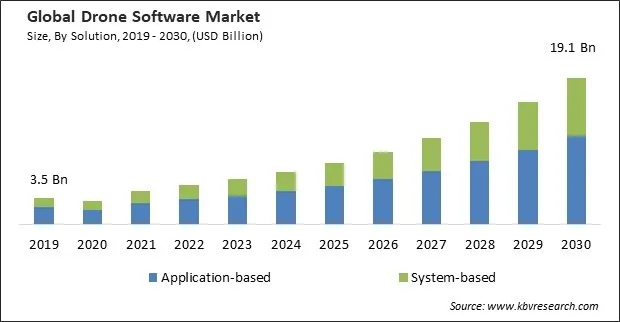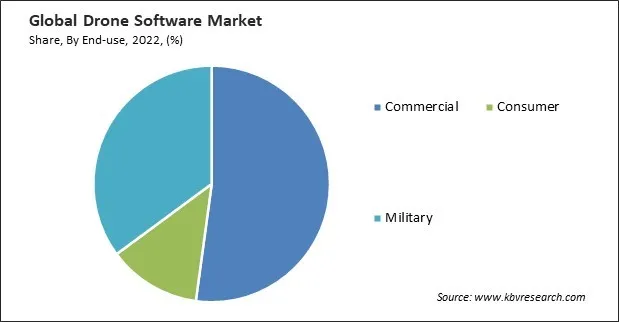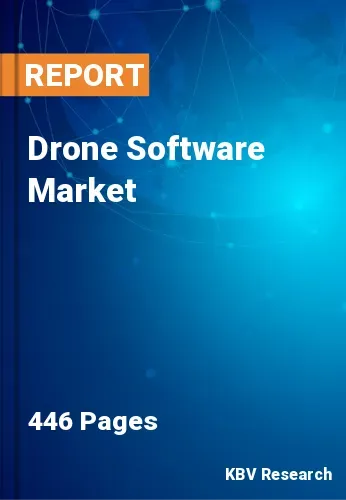The Global Drone Software Market size is expected to reach $19.1 billion by 2030, rising at a market growth of 18% CAGR during the forecast period.
Drones with advanced sensors, cameras, and specialized software solutions are increasingly used for various industry surveillance and monitoring applications. Drones are used for border surveillance, providing real-time tracking and monitoring of border areas. Consequently, the surveillance & monitoring segment would generate approximately 15% share of the market by 2030. Drones are used for maritime surveillance, including tracking vessels, monitoring illegal fishing, and responding to oil spills. The software helps in tracking vessel movements and analyzing environmental data. Drone software is pivotal in collecting, analyzing, and visualizing data, providing actionable insights, and enhancing decision-making processes in surveillance and monitoring operations. Some of the factors affecting the market are growing technological advancements, increasing use of drones for commercial purposes, and limited drone battery life.

Advances in drone hardware and software, including improvements in sensors, cameras, artificial intelligence (AI), and machine learning, enhance the capabilities and efficiency of drones, prompting the development of more sophisticated software solutions. High-resolution cameras, thermal imaging sensors, LiDAR (Light Detection and Ranging), multispectral cameras, and hyperspectral sensors provide drones with advanced data capture capabilities. These sensors enable more detailed and accurate data collection for various applications. Furthermore, Precision agriculture relies on drones with specialized sensors and cameras for crop monitoring, pest control, and yield optimization. Drone software processes data to provide actionable insights for farmers, increasing productivity and reducing resource usage. In construction and real estate, drones are used for site inspections, progress monitoring, and 3D modelling. Drone software aids in project management, site analysis, and decision-making, streamlining construction operations. This trend is expected to drive further growth in the market.
However, Limited battery life restricts the amount of time a drone remains airborne. This can be a significant constraint for missions that require extended flight durations, such as long-distance surveying, search and rescue operations, or monitoring large agricultural fields. Drones with short battery life cover less ground or capture fewer data points during a single flight. This limits their efficiency and effectiveness, particularly in applications like aerial mapping or surveillance, where comprehensive coverage is essential. This is a safety concern, especially in urban or populated areas. Limited battery life is a significant challenge in the market.
By solution, the market is categorized into system-based and application-based. In 2022, the application-based segment held the highest revenue share in the market. This is attributable to features such as comprehensive and integrated software platforms that accommodate a variety of drone-related functions, such as mission planning, flight management, and data analytics, among others. In addition, application-based solutions expedite workflows by integrating different aspects of drone operations into a single platform. Due to the increased operational effectiveness, which enables users to handle and analyze data more efficiently while decreasing manual labour and saving time, the segment is anticipated to rise throughout the forecast period.
Based on architecture, the market is bifurcated into open source and closed source. The closed source segment garnered a significant revenue share in the market in 2022. Certain businesses create closed-source drone software to safeguard their exclusive features and intellectual property. This exclusivity gives companies a competitive edge and encourages them to invest in R&D. As a result, novel and distinctive software solutions are produced, which are anticipated to drive segment expansion during the projected period.
On the basis of deployment, the market is divided into onboard and ground-based. In 2022, the onboard segment registered the maximum revenue share in the market. Real-time data processing and analysis are made possible by onboard deployment, which enables software programs to run directly on the embedded systems of the drone. This capability is essential for applications that require instantaneous decisions and responses, such as autonomous flight control and obstacle avoidance. These characteristics have contributed to the substantial share of the onboard segment during the projected period.
On the basis of drone type, the market is divided into fixed wing, rotary blade, and hybrid. The hybrid segment garnered a significant revenue share in the market in 2022. Hybrid commercial drones incorporate characteristics of both fixed-wing and rotary-blade drones, making them more efficient and practicable. Combining the characteristics of batteries and fuel, hybrid commercial drones increase their effectiveness and power. Additionally, even in adverse weather, these drones can fly for extended periods with greater payloads, which is anticipated to fuel the hybrid segment's growth over the projected period.
By end-use, the market is segmented into commercial, consumer, and military. In 2022, the commercial segment dominated the market with maximum revenue share. The market is evolving due to the expanding enterprise use of drones across numerous industry verticals. Numerous drone producers consistently develop, test, and improve software and services for various markets. Additionally, improvements in drone technology have lowered the cost of payloads and software systems.

Based on vertical, the market is categorized into agriculture, construction & mining, defense & government, energy & utilities, media & entertainment, logistics & transportation, and others. The defense and government segment acquired a substantial revenue share in the market in 2022. Drones are extensively used for surveillance and reconnaissance missions by defense agencies. They provide military personnel with real-time video and image feeds, enhancing situational awareness. Drone software allows for controlling, monitoring, and analyzing the data collected during these missions. Drones with advanced sensors, cameras, and communication systems can collect valuable intelligence data.
By application, the market is fragmented into filming & photography, inspection & maintenance, mapping & Surveying, precision agriculture, surveillance & monitoring, search & rescue, and others. In 2022, the filming & photography segment led the market by generating highest revenue share. An increase in events, such as weddings, sports and race events, and educational ceremonies, generates a strong demand for capturing high-quality photographs and recordings, contributing to the segment's expansion. In addition, drones offer advantages for videography and photography due to their small size, portability, maneuvering, and extremely low operational cost, which is anticipated to fuel segment expansion during the anticipated period.
| Report Attribute | Details |
|---|---|
| Market size value in 2022 | USD 5.2 Billion |
| Market size forecast in 2030 | USD 19.1 Billion |
| Base Year | 2022 |
| Historical Period | 2019 to 2021 |
| Forecast Period | 2023 to 2030 |
| Revenue Growth Rate | CAGR of 18% from 2023 to 2030 |
| Number of Pages | 446 |
| Number of Table | 760 |
| Report coverage | Market Trends, Revenue Estimation and Forecast, Segmentation Analysis, Regional and Country Breakdown, Competitive Landscape, Companies Strategic Developments, Company Profiling |
| Segments covered | Solution, Architecture, Deployment, Drone Type, End-use, Vertical, Application, Region |
| Country scope | US, Canada, Mexico, Germany, UK, France, Russia, Spain, Italy, China, Japan, India, South Korea, Singapore, Malaysia, Brazil, Argentina, UAE, Saudi Arabia, South Africa, Nigeria |
| Growth Drivers |
|
| Restraints |
|
Region-wise, the market is analysed across North America, Europe, Asia Pacific, and LAMEA. In 2022, the Asia Pacific region acquired a significant revenue share in the market. This rise is mostly ascribed to China's thriving market, Japan's developed consumer electronics sector, and the rising demand for drones in emerging markets like India and Southeast Asian economies. The demand has increased due to the rapid improvement of technology and the growing use of drone technology across numerous sectors. Diverse industries in the region, including agriculture, construction, infrastructure, and logistics, are recognizing the potential benefits of drones and the value they bring to their operations, which is anticipated to fuel the regional demand for market.
Free Valuable Insights: Global Drone Software Market size to reach USD 19.1 Billion by 2030
The market research report covers the analysis of key stakeholders of the market. Key companies profiled in the report include Kespry, Inc., SZ DJI Technology Co., Ltd. (iFlight Technology Company Limited), DroneDeploy, Inc., Esri, Inc., Pix4D SA, PrecisionHawk, Inc., AgEagle Aerial Systems, Inc., Skydio, Inc., AirMap Inc. (DroneUp, LLC), DELAIR SAS.
By Solution
By Architecture
By Deployment
By Drone Type
By End use
By Vertical
By Application
By Geography


This Market size is expected to reach $19.1 billion by 2030.
Growing technological advancements are driving the Market in coming years, however, Limited drone battery life restraints the growth of the Market.
Kespry, Inc., SZ DJI Technology Co., Ltd. (iFlight Technology Company Limited), DroneDeploy, Inc., Esri, Inc., Pix4D SA, PrecisionHawk, Inc., AgEagle Aerial Systems, Inc., Skydio, Inc., AirMap Inc. (DroneUp, LLC), DELAIR SAS.
The Rotary Blade segment is generating the maximum revenue in the Market by Drone Type in 2022; thereby, achieving a market value of $13.7 billion by 2030.
The Open-Source segment is leading the Market by Architecture in 2022; thereby, achieving a market value of $11 billion by 2030.
The North America region dominated the Market by Region in 2022, and would continue to be a dominant market till 2030; thereby, achieving a market value of $6.6 billion by 2030.
Our team of dedicated experts can provide you with attractive expansion opportunities for your business.

